In this article, we see how a farmer has grown papaya successfully and is earning huge profits from his venture. Below we will learn about Mr. Ramesh’s papaya farm, his experiences, cultivation details of papaya plants, his investment, and income details.
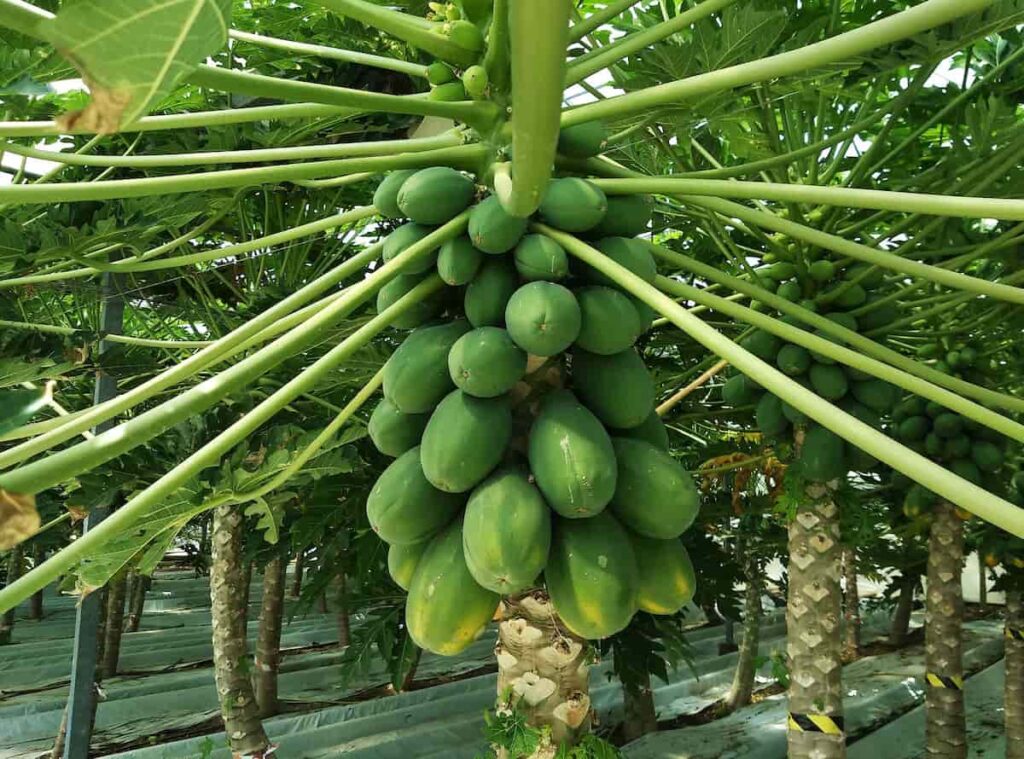
How this farmer earning 30 lakhs from papaya cultivation in 6 acres
How many months will papaya bear fruit?
If you take good care of your plants, you can see fruits as early as four months after planting and fruit as late as 11 months. Papaya plants yield varying amounts of fruit depending on where they are grown, the time of year, and how well they are cared for. For optimal development and yield, papaya trees should be sited in a sunny location. Pick a spot far from any other trees, buildings, or structures, as well as any overhead electricity lines. Find the sunniest spot that won’t be flooded (or soggy) during a regular summer storm.
What is the best way to grow papaya?
To thrive, papaya trees need considerable amounts of manure and fertilizers. Manures are essential, but fertilizers are also necessary. Soil test results and recommendations for a certain agroecological zone should inform how much and what nutrients are applied to the soil. A 60 cm x 60 cm x 60 cm trench is ideal for planting papaya seedlings. In the summer, the holes are dug approximately two weeks before planting.
The pits are amended with 20 kilograms of farmyard manure, 1 kilogram each of neem cake and bone meal, and then covered with topsoil. The highest fruit output can be achieved with an N application of 200 g. N/pit; however, papain production improves with N applications of up to 300 g/pit. Plant only weed-free seedlings. When planting, physically remove weeds from the planting pits and surrounding areas.
Add organic mulch around the holes. Intercropping shallow-rooted crops following deeply-rooted ones, or vice versa, is an effective method of weed control between rows. Once the blooming stage has begun, no further intercropping will occur. When you want to prevent the development of weeds and keep the soil wet for an extended time, use straw or plastic mulch.
In case you missed it:How this Farmer Earning 50 Lakhs From his 5 Acres Farm: A Success Story of a Vegetable Farmer in India
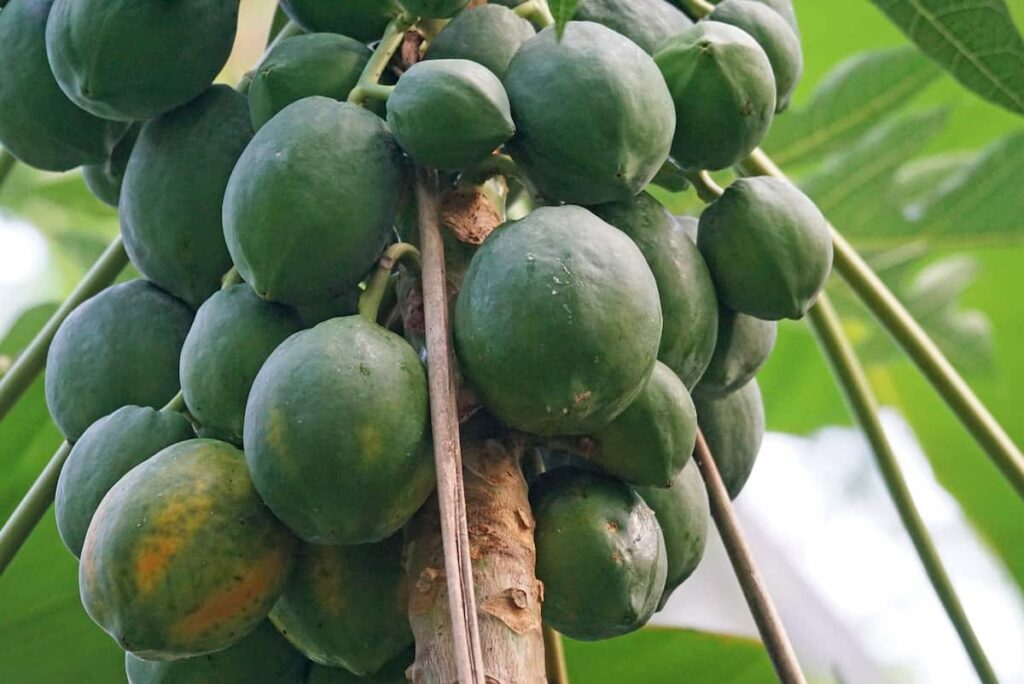
How much water do papaya crops need?
A wide range of local variables affect how much water papaya needs, including but not limited to sunlight availability, temperature, rainfall, wind, soil type, and more. The age of the plant also has a role. More water is required for a young papaya plant than for an established tree. This is because the vegetative growth rate of older trees is reduced. Because of this, saplings require watering once or twice weekly, but fruit trees only need it once every 15 days.
“Mature trees have a higher water need. However, plants will die under waterlogging conditions since their roots are so superficial. It causes the fruit to rot and leads to””wet feet.” Hence, it is recommended to use drip irrigation while cultivating papaya trees. Watering papaya once a week during the summer and every 10 to 12 days during the winter is required until the rains start.
“Mature trees have a higher water need. However, plants will die under waterlogging conditions since their roots are so superficial. It causes the fruit to rot and leads to “wet feet.” Hence, it is recommended to use drip irrigation while cultivating papaya trees. Watering papaya once a week during the summer and every 10 to 12 days during the winter is required until the rains start.
The best times to sow papaya seeds are during the monsoon, fall, and spring. However, not planting it in the winter prevents frost from harming the crop. Thus, they are sown in the months of June and July (monsoon), October and November (autumn), or February and March (spring) (summer). Weather conditions are of the utmost importance when growing papaya since rain, frost, and hot air may easily damage the plant.
Do papaya trees like sun or shade?
Papayas thrive in warm, sunny locations, away from other plants, structures, and overhead electricity lines. Planting two or three papaya trees at a distance of 7 to 12 feet (2.1 to 3.7 meters) from one another increases the odds that at least one of them will bear fruit and makes it easier to tend to the trees’ nutritional needs and watering requirements.
In case you missed it: Earning 70 Lakhs from Rose Cultivation in 5 Acre Polyhouse: The Success Story of a Flower Farmer
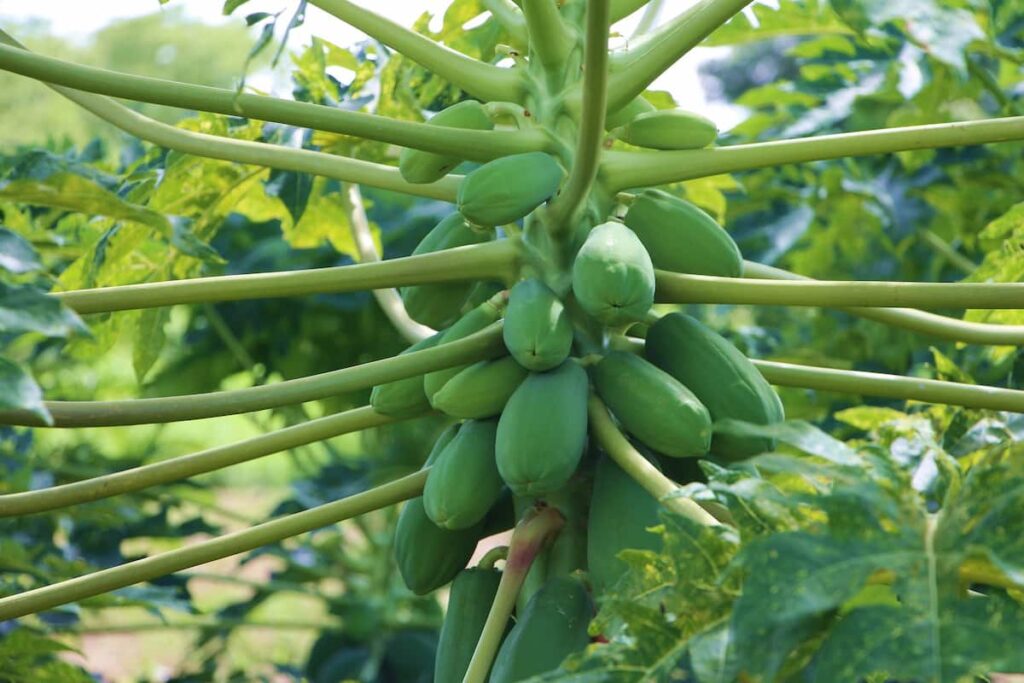
How many years does it take for papaya to grow?
Flowering on papaya trees begins in the third or fourth month, while fruit maturity occurs between seven and nine months in hotter regions and nine to eleven months in colder ones. There might be as many as one hundred papayas harvested from a single tree in a growing season. The fruits are ready for picking when they reach full maturity and become a pale yellow at their very tips. The presence of latex is also a sign that it is ready to harvest.
The fruits are ready to be picked when the latex becomes watery instead of milky. When ripe, not all papayas are yellow. When mature, some varieties become yellow, while others retain their original green color. Papaya has a short economic lifespan, often no more than four years. Nonetheless, growers don’t use it for more than two or three years since productivity starts to drop down after that. However, papaya output can be greatly increased with the help of good farm management and appropriate treatment.
How to prepare land for papaya cultivation?
The ideal site for growing papaya is sheltered from storms and doesn’t get boggy when it rains. There should be windbreaks surrounding the property in case of high winds. The seeds are initially seeded in nurseries, and the seedlings are moved to the main field after around 6-8 weeks of development.
Digging trenches a month before transplanting and filling them with farm yard manure, organic waste, and soil is standard practice. Two or three seedlings are put in each hole. You should only keep one plant per hole as soon as the plants produce flowers. For the first year, frequent hoeing is performed to prevent weed growth. Once the trees bloom, just 10% of the male plants are left in the orchard.
Should we mulch papaya plants?
If you’re growing papaya, mulching is a good way to keep the soil around the tree wet, prevent weeds from growing up around the tree’s base, and enrich the top few inches of soil. Spread a 2- to 6-inch (5- to 15-cm) layer of mulch, such as bark or wood chips. The safest distance between the mulch and the trunk is 8-12 inches (20-30 cm).
In case you missed it: Earning 6 Lakhs from 5 Acre Apple Ber/Jujube Farm: An Inspirational Story of a Farmer in India
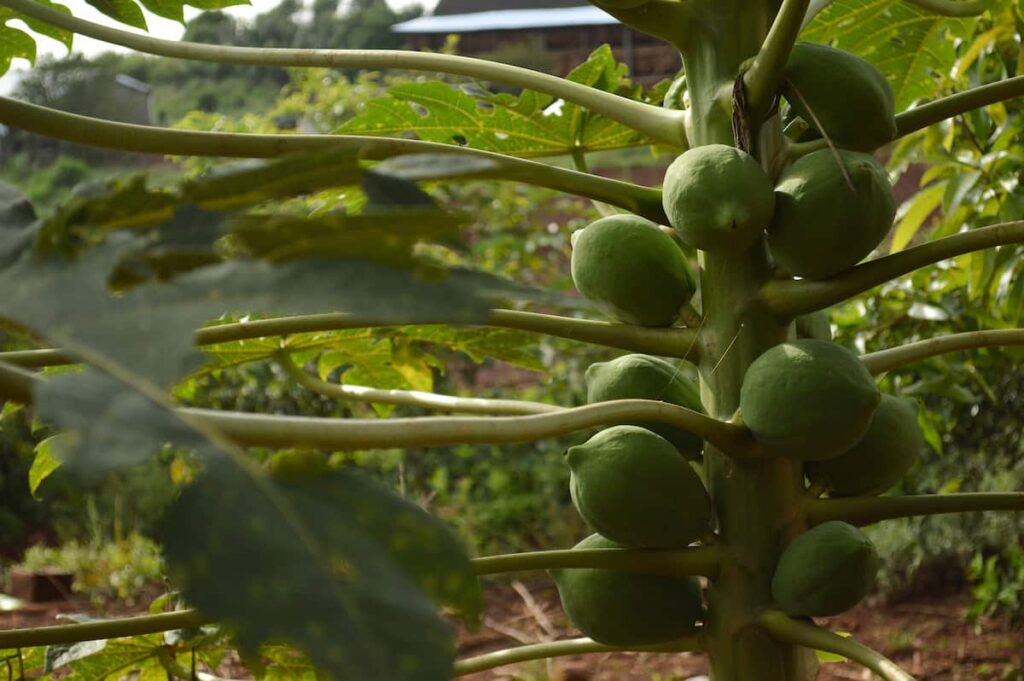
How to protect papaya plants?
For this reason, frost protection is essential for North Indian papaya farms. The months of December through February are prime frost months. Planting is a seasonal activity that must be completed before the first frost of the year. Moreover, polythene bags proportional to the size of the plants are thatched over them to provide further protection. The tops of the bags must have ventilation holes punched in them. That’s for the first year of winter. The next year, cover the plant with gunny sacks around the fruit and at the top.
Anthracnose, powdery mildew, stem rot, and damping-off are the most common diseases that attack papaya plants. The most common cause of rot is water accumulation around the roots. Effective treatments for these illnesses include wettable sulfur, carbendazim, and mancozeb. Papaya plants are preyed upon by aphids, red spider mites, stem borer, fruit flies, grey weevils, and grasshoppers. They may be managed by spraying preventative chemicals, such as 0.3% dimethoate, and destroying the contaminated area.
The success story of Mr. Ramesh
Mr. Ramesh is a farmer based in the Karimnagar district of Telangana. He used to cultivate different vegetable crops in the past, but due to some financial issues and low market prices, he couldn’t keep the cultivation going. As a result, he was drowned in debt and started working as a supervisor in a construction company. He owns nearly 6 acres of land, which he used to cultivate different vegetables.
Although he failed, he wanted to cultivate something new for his farm. He wanted to grow a long-term crop that would give him a good yield and higher profits. While working for the construction company, he gathered capital and investigated different crops that could be grown in his field. While he was still in a dilemma, he heard about papaya cultivation and how the prices were currently high.
He investigated a bit about this crop, and he saw a huge potential for profits. He learned cultivation techniques while he was still working for the construction company. Once he gathered the capital, he returned to his village and started papaya cultivation on his 6-acre farm. Mr. Ramesh is a successful farmer earning huge profits from his papaya farm. We will now learn about his experiences, cultivation details, investment, and profit details.
Plant selection details, according to Mr. Ramesh
Mr. Ramesh mainly selected papaya cultivation because of the surge in the market price of papayas. Also, it is a long-term crop and can be grown for up to 3 years, which is exactly what Mr. Ramesh wanted. While investigating the crop before he started his venture, he came to know that there was a new variety of papaya, which was booming. This variety is called Taiwan red lady F1. He learned that these papayas have very good high-yielding and quality-yielding percentages. This was the reason he chose these crops for cultivation.
In case you missed it: How this Farmer Earning 8 Lakhs from 3 Acres Sweet Orange Cultivation – A Success Story of a Mosambi/Sweet Lemon Farmer
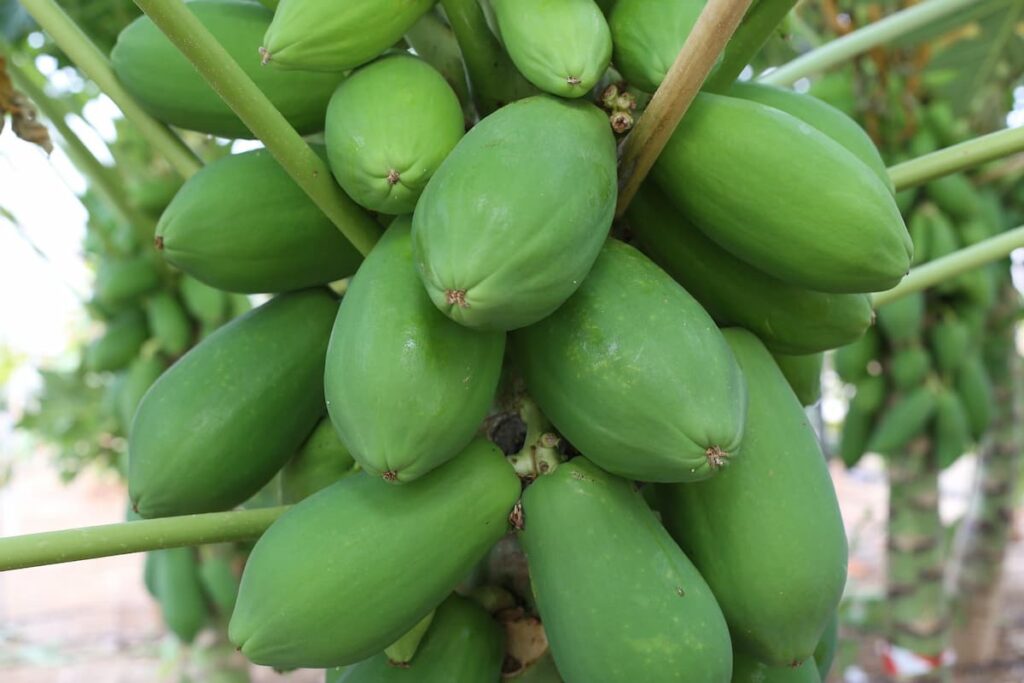
Papaya plant cultivation details, in Mr. Ramesh’s words
Mr. Ramesh says that there is a major issue with Papaya cultivation, which is the mosaic virus. In the past years, this virus has been destroying many papaya farms. To prevent this, he added that farmers must be very careful when choosing the variety. He says you should first learn if this virus is active in your region. If it is, you have to care by consulting the horticultural scientists, who will recommend the appropriate variety.
This is what he did, says Mr. Ramesh. As the mosaic virus spread is high in his region, he chose Taiwan red lady variety. This variety is still prone to the virus disease but less than the other varieties. The virus control is easy with this variety, he added. Instead of buying seedlings, Mr. Ramesh bought and made saplings for himself. He says that this can reduce his investment to some extent, and also, as we take care of the crop from the initial stages, we get quality output at the time of harvest.
You must provide COC (3gm per liter) to these saplings at the early stages. Also, to protect them from future pests, you must provide Carbophurene 3g for these plants to become immune to many pests. For land preparation, Mr. Ramesh added chicken manure, cow manure, and other animal manure to his farm. Then the land is plowed again to mix these manures well with soil. Once the land preparation is done, you must create rows and mounds with proper spacing.
He chose a spacing of 6 * 6 feet on his farm between plants. This means there is a 6 ft distance between rows and a 6 ft distance between the plants in rows. By using this spacing, you can plant nearly 1000 to 1100 plants per acre, says Mr. Ramesh. You can spot Alternaria leaf spot disease in October and November on your plants. To control this, you must spray Mancozeb fungicide (2.5 to 3 gm per liter) on your plants. You have to use this as soon as you spot the leaf disease, or else it will become a hassle for you afterward.
To control powdery mildew, you must spray dissolvable sulfur (3 gm per liter) on your plants. As a fertilizer for your plants, you have to provide your plants with Trichoderma, neem cake, animal manure, and compost if necessary. Also, you have to install blue and yellow sticky plates on your farm. If any of your trees are infected with the mosaic virus, they have to be removed as soon as possible as they can spread it to other plants, says Mr. Ramesh.
Weeding is one of the most critical aspects of this cultivation. Hand-picking process is ideal for removing weeds. It is not advised to spray chemicals to eliminate weeds, as they can make your soil unfertile. When it comes to watering, drip irrigation is ideal for this cultivation, as it involves less water wastage and more efficiency. Boron and zinc deficiency are the most common deficiencies for papaya plants. To control this, add boron (1 gm per liter) and zinc sulfate (5 gm per liter) once a month.
In case you missed it: How this Farmer is Earning 24 Lakh from Custard Apple Cultivation: 4 Acres Farming Sucess Story
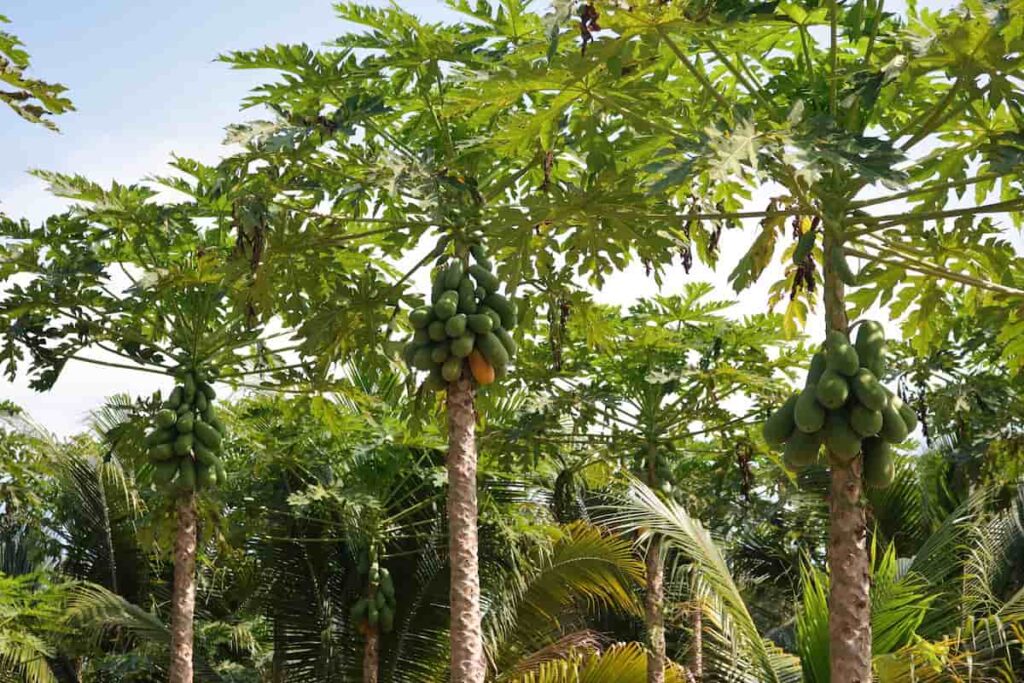
Investment and profit analysis of Mr. Ramesh’s papaya farm
While harvesting, you can expect nearly 50 to 60 kgs from each plant. This means we can harvest nearly 50 to 60 tons per acre, says Mr. Ramesh. Mr. Ramesh says he sells his harvest at nearly 10 to 12 rupees per kg. He gets an income of rupees 5 to 6 lakhs per acre. For his 6 acres, it took him nearly 6 lakh rupees, including everything says, Mr. Ramesh.
Now, if we calculate the income for this whole farm, he earns rupees 36 lakh. If we erase the investment, his net profit would be nearly 30 lakh rupees. This is huge for a farmer. Mr. Ramesh is now a reputable farmer in his village, who earns huge profits from his papaya farm, and is very happy and satisfied. He is debt free now and is willing to guide his fellow farmers into papaya cultivation.
- Economical Aquaculture: A Guide to Low-Budget Fish Farming
- 15 Common Planting Errors That Can Doom Your Fruit Trees
- How to Make Houseplants Bushy: Effective Tips and Ideas
- Innovative Strategies for Boosting Coconut Pollination and Yield
- Pollination Strategies for Maximum Pumpkin Yield
- The Complete Guide to Chicken Fattening: Strategies for Maximum Growth
- Natural Solutions for Tulip Problems: 100% Effective Remedies for Leaf and Bulb-Related Issues
- Revolutionizing Citrus Preservation: Towards a Healthier, Greener Future
- Natural Solutions for Peony Leaf and Flower Problems: 100% Effective Remedies
- Maximizing Profits with Avocado Contract Farming in India: A Comprehensive Guide
- Natural Solutions for Hydrangea Problems: 100% Effective Remedies for Leaf and Flowers
- The Ultimate Guide to Choosing the Perfect Foliage Friend: Bringing Life Indoors
- From Sunlight to Sustainability: 15 Ways to Use Solar Technology in Agriculture
- The Ultimate Guide to Dong Tao Chicken: Exploring from History to Raising
- The Eco-Friendly Makeover: How to Convert Your Unused Swimming Pool into a Fish Pond
- Mastering the Art of Delaware Chicken Farming: Essentials for Healthy Backyard Flocks
- 20 Best Homemade Fertilizers for Money Plant: DIY Recipes and Application Methods
- How to Craft a Comprehensive Free-Range Chicken Farming Business Plan
- Brighten Your Flock: Raising Easter Egger Chickens for Beauty and Bounty
- How to Optimize Your Poultry Egg Farm Business Plan with These Strategies
- Subsidy for Spirulina Cultivation: How Indian Government Schemes Encouraging Spirulina Farmers
- Ultimate Guide to Raising Dominique Chickens: Breeding, Feeding, Egg-Production, and Care
- Mastering the Art of Raising Jersey Giant Chickens: Care, Feeding, and More
- Ultimate Guide to Raising Legbar Chickens: Breeding, Farming Practices, Diet, Egg-Production
- How to Raise Welsummer Chickens: A Comprehensive Guide for Beginners
- How to Protect Indoor Plants in Winter: A Comprehensive Guide
- Ultimate Guide to Grow Bag Gardening: Tips, Tricks, and Planting Ideas for Urban Gardeners
- Guide to Lotus Cultivation: How to Propagate, Plant, Grow, Care, Cost, and Profit
- Agriculture Drone Subsidy Scheme: Government Kisan Subsidy, License, and How to Apply Online
- Ultimate Guide to Raising Araucana Chickens: Breed Profile, Farming Economics, Diet, and Care
- Bringing Hydroponics to Classroom: Importance, Benefits of Learning for School Students
- Ultimate Guide to Raising Polish Chickens: Breed Profile, Farming Economics, Diet, and Care
- Ultimate Guide to Raising Australorp Chickens: Profile, Farming Economics, Egg Production, Diet, and Care
- Silkie Chicken Farming: Raising Practices, Varieties, Egg Production, Diet, and Care
- Sussex Chicken Farming: Raising Practices, Varieties, Egg Production, Diet and Care
- Homemade Feed Formulations for Livestock: Discover Cost-effective Starter to Finisher Feed Recipes